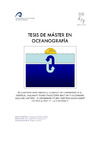Identificador persistente para citar o vincular este elemento:
https://accedacris.ulpgc.es/handle/10553/85978
| Campo DC | Valor | idioma |
|---|---|---|
| dc.contributor.advisor | Hernández León, Santiago Manuel | - |
| dc.contributor.author | Vicente Ariza, Alejandro | - |
| dc.date.accessioned | 2021-03-10T23:27:57Z | - |
| dc.date.available | 2021-03-10T23:27:57Z | - |
| dc.date.issued | 2012 | en_US |
| dc.identifier.other | Gestión académica | - |
| dc.identifier.uri | https://accedacris.ulpgc.es/handle/10553/85978 | - |
| dc.description.abstract | Diel vertical migrants (DVMs) are mainly zooplankton and micronekton migrating upward from 400-700 m depth every night to feed in the productive epipelagic zone and downward at dawn to the mesopelagic zone, where they release the ingested carbon. This is the so-called Active Flux, an important component of the Ocean Carbon Pump. Around 70% micronektonic DVMs biomass are lanternfishes (myctophidae). Therefore, myctophids might represent a pathway accounting for a substantial export of organic carbon to deeper waters. In order to assess the efficiency of the micronekton active flux, here we study the migration pattern and the feeding ecology in Hygophum hygomii and Lobianchia dofleini, two dominant myctophids in the Subtropical Eastern North Atlantic. Our results show that both populations are split in migratory and non-migratory individuals. The last ones were in a deprivation and post-digesting state with full stomachs of non-fresh food. This suggests that the evacuation rate is long enough to export efficiently most of the ingested food to the mesopelagic zone. The daily ration of the migratory individuals was 1.99 ±0.18 and 1.34 ±0.45 % of body dry weight of H. hygomii and L. dofleini respectively, feeding mainly on copepods and euphausiids. The feeding strategies and the migration patterns are discussed in order to provide further information concerning the micronekton active flux efficiency. | en_US |
| dc.language | eng | en_US |
| dc.relation | Ciclos Lunares y Fertilización Con Hierro. | en_US |
| dc.subject | 251001 Oceanografía biológica | en_US |
| dc.subject.other | Diel Vertical Migrants | en_US |
| dc.subject.other | Myctophids | en_US |
| dc.subject.other | Micronekton | en_US |
| dc.subject.other | Active flux | en_US |
| dc.subject.other | Feeding ecology | en_US |
| dc.title | Migration and feeding ecology of dominant diel vertical migrants fishes, in the Canary Islands waters | en_US |
| dc.type | info:eu-repo/semantics/masterThesis | en_US |
| dc.type | MasterThesis | en_US |
| dc.contributor.centro | IU de Oceanografía y Cambio Global | en_US |
| dc.contributor.departamento | Departamento de Biología | en_US |
| dc.contributor.facultad | Facultad de Ciencias del Mar | en_US |
| dc.investigacion | Ciencias | en_US |
| dc.type2 | Trabajo final de máster | en_US |
| dc.utils.revision | Sí | en_US |
| dc.identifier.matricula | TFT-30482 | - |
| dc.identifier.ulpgc | Sí | en_US |
| dc.contributor.buulpgc | BU-BAS | en_US |
| dc.contributor.titulacion | Máster Universitario en Oceanografía | - |
| item.fulltext | Con texto completo | - |
| item.grantfulltext | open | - |
| crisitem.author.fullName | Vicente Ariza,Alejandro | - |
| crisitem.advisor.dept | GIR IOCAG: Oceanografía Biológica y Cambio Global | - |
| crisitem.advisor.dept | IU de Oceanografía y Cambio Global | - |
| crisitem.advisor.dept | Departamento de Biología | - |
| crisitem.project.principalinvestigator | Hernández León, Santiago Manuel | - |
| Colección: | Trabajo final de máster | |
Visitas
43
actualizado el 27-ene-2024
Descargas
35
actualizado el 27-ene-2024
Google ScholarTM
Verifica
Comparte
Exporta metadatos
Los elementos en ULPGC accedaCRIS están protegidos por derechos de autor con todos los derechos reservados, a menos que se indique lo contrario.
